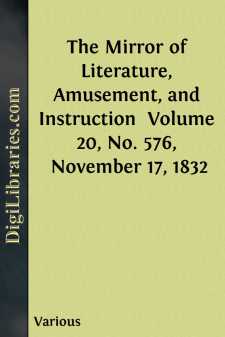Categories
- Antiques & Collectibles 13
- Architecture 36
- Art 48
- Bibles 22
- Biography & Autobiography 813
- Body, Mind & Spirit 142
- Business & Economics 28
- Children's Books 14
- Children's Fiction 11
- Computers 4
- Cooking 94
- Crafts & Hobbies 4
- Drama 346
- Education 46
- Family & Relationships 57
- Fiction 11829
- Games 19
- Gardening 17
- Health & Fitness 34
- History 1377
- House & Home 1
- Humor 147
- Juvenile Fiction 1873
- Juvenile Nonfiction 202
- Language Arts & Disciplines 88
- Law 16
- Literary Collections 686
- Literary Criticism 179
- Mathematics 13
- Medical 41
- Music 40
- Nature 179
- Non-Classifiable 1768
- Performing Arts 7
- Periodicals 1453
- Philosophy 64
- Photography 2
- Poetry 896
- Political Science 203
- Psychology 42
- Reference 154
- Religion 513
- Science 126
- Self-Help 84
- Social Science 81
- Sports & Recreation 34
- Study Aids 3
- Technology & Engineering 59
- Transportation 23
- Travel 463
- True Crime 29
The Mirror of Literature, Amusement, and Instruction Volume 20, No. 576, November 17, 1832
by: Various
Categories:
Description:
Excerpt
WINGFIELD MANOR-HOUSE.
This interesting structure is referred to by a clever writer as one of the richest specimens extant of the highly-ornamented embattled mansions of the time of Henry VII. and VIII., the period of transition from the castle to the palace, and undoubtedly the best aera of English architecture. This judgment will be found confirmed in the writings of distinguished antiquarians; and the reader's attention to the descriptive details of this building will be important in connexion with several notices, in our recent pages, of old English domestic architecture.
The manor of Wingfield, or Winfield, is situated four or five miles to the eastward of the centre of Derbyshire. The early lords had two parks, which, according to a survey made in 1655, contained nearly 1,100 acres. These parks are now divided into farms: on the border of one of them are a moat and other remains of an ancient mansion, traditionally said to have been called Bakewell Hall; by some, this is supposed to have been the original mansion, which is said by others to have been near the Peacock Inn, on the road between Derby and Chesterfield. The present Manor-House, (as represented in the Engraving,) according to Camden, was built about the year 1440, by Ralph, Lord Cromwell, in the time of Henry VI. This Lord Cromwell was treasurer of England; and the testimony of Camden that he was the founder, is strongly corroborated by the bags or purses of stones, (alluding to the office of treasurer which he filled,) carved over the gateway leading into the quadrangle. Bags or purses are mentioned to have been carved on the manor-house of Coly Weston, in Northamptonshire, augmented by this Lord Cromwell; and there were also similar ornaments carved in wood, removed about a century ago from Wingfield Manor.
The Manor-House originally consisted of two square courts, one of which, to the north, has been built on all sides, and the south side of it forms the north side of the south court, which has also ranges of buildings on the east and west sides, and on part of the south. The latter court seems principally to have consisted of offices. The first entrance is under an arched gateway on the east side of the south court. The arch of this gateway being a semicircle, was probably erected subsequently to the rest of the building: hence the communication with the inner court is under an arched gateway in the middle of the north side of the south court. One half of this range of building seems originally to have been used as a hall, which was lighted by a beautiful octagon window, and through a range of Gothic windows to the south, now broken away, and a correspondent range to the north. This part of the house was afterwards divided and subdivided into several apartments: these have suffered the same fate as the noble hall, the magnificence of which their erection destroyed. In the other part of this range are the portal, the remains of the chapel, and of the great state apartment, lighted by another rich Gothic window....












